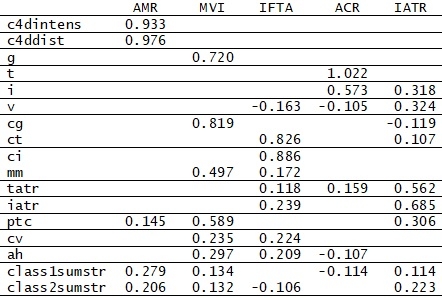Factor Analysis (FA) Identifies 5 Major Axes of Kidney Transplant Biopsy (KTxBx) Pathology
1Int. Med., U. Iowa, Iowa City, IA
2Pathology, Mayo Clinic, Rochester, MN
3Immunogenetics, UCLA, Los Angeles, CA
4Surgery, U. Minnesota, Minneapolis, MN.
Meeting: 2018 American Transplant Congress
Abstract number: 312
Keywords: Biopsy, Kidney transplantation, Multicenter studies, Risk factors
Session Information
Session Name: Concurrent Session: Kidney Complications: Diagnostic Considerations
Session Type: Concurrent Session
Date: Monday, June 4, 2018
Session Time: 4:30pm-6:00pm
 Presentation Time: 5:06pm-5:18pm
Presentation Time: 5:06pm-5:18pm
Location: Room 6C
Definitions for acute rejection (ACR) and antibody mediated rejection (AMR) in KTxBx exist, but no data driven methods exist for quantitative analysis of all Banff, C4d, and donor specific antibody (DSA) data from KTxBx. We used FA to identify and quantify underlying patterns of injury in "for cause" KTxBx from patients in two DeKaf cohorts.
Methods: The Cross-Sectional Cohort (CSC) included patients >6 months after transplant (Tx) with stable serum creatinine (Scr) before 2006 undergoing KtxBx for rise in Scr or new proteinuria. The Prospective Cohort (PC) entered new KTx; those biopsied for renal injury >3 months post-Tx are included in this report. Data include 11 Banff KTxBx variables, inflammation/tubulitis in areas of atrophy (IATR/TATR), C4d staining intensity and % capillaries stained, and total strengths of Class 1 and 2 donor specific antibodies (DSAs). Complete data were available from 380 and 191 index biopsies from the CSC and PC. FA was performed on correlation matrices of the above variables. Results were expressed as variable "loadings" on and correlations among the Factors. Data from the two independent cohorts were analyzed separately.
Results: FA analysis of both cohorts (CSC results in table) revealed five distinct axes of injury (Factors): antibody mediated rejection (AMR), microvascular inflammation (MVI), interstitial fibrosis/tubular atrophy (IFTA), acute cellular rejection (ACR), and IATR/TATR (IATR). While ptc has a small loading on AMR, MVI as a whole was negatively correlated with AMR and uncorrelated with ACR.  Five Factor scores were obtained for each Bx by multiplication of the variables by the Factor loadings. The loadings and correlations from CSC and PC analyses were virtually identical.
Five Factor scores were obtained for each Bx by multiplication of the variables by the Factor loadings. The loadings and correlations from CSC and PC analyses were virtually identical.
Conclusions: FA permits quantitation of five major axes of injury in KTXBX using Banff , C4d, and DSA scores, and may facilitate evaluation of the pathogenesis and consequences of these injuries. MVI appears to be largely uncorrelated with AMR or ACR and may have additional causes.
CITATION INFORMATION: Hunsicker L., Grande J., Cecka J., Matas A., The DeKaf Consortium Factor Analysis (FA) Identifies 5 Major Axes of Kidney Transplant Biopsy (KTxBx) Pathology Am J Transplant. 2017;17 (suppl 3).
To cite this abstract in AMA style:
Hunsicker L, Grande J, Cecka J, Matas A, Consortium TheDeKaf. Factor Analysis (FA) Identifies 5 Major Axes of Kidney Transplant Biopsy (KTxBx) Pathology [abstract]. https://atcmeetingabstracts.com/abstract/factor-analysis-fa-identifies-5-major-axes-of-kidney-transplant-biopsy-ktxbx-pathology/. Accessed December 15, 2025.« Back to 2018 American Transplant Congress
